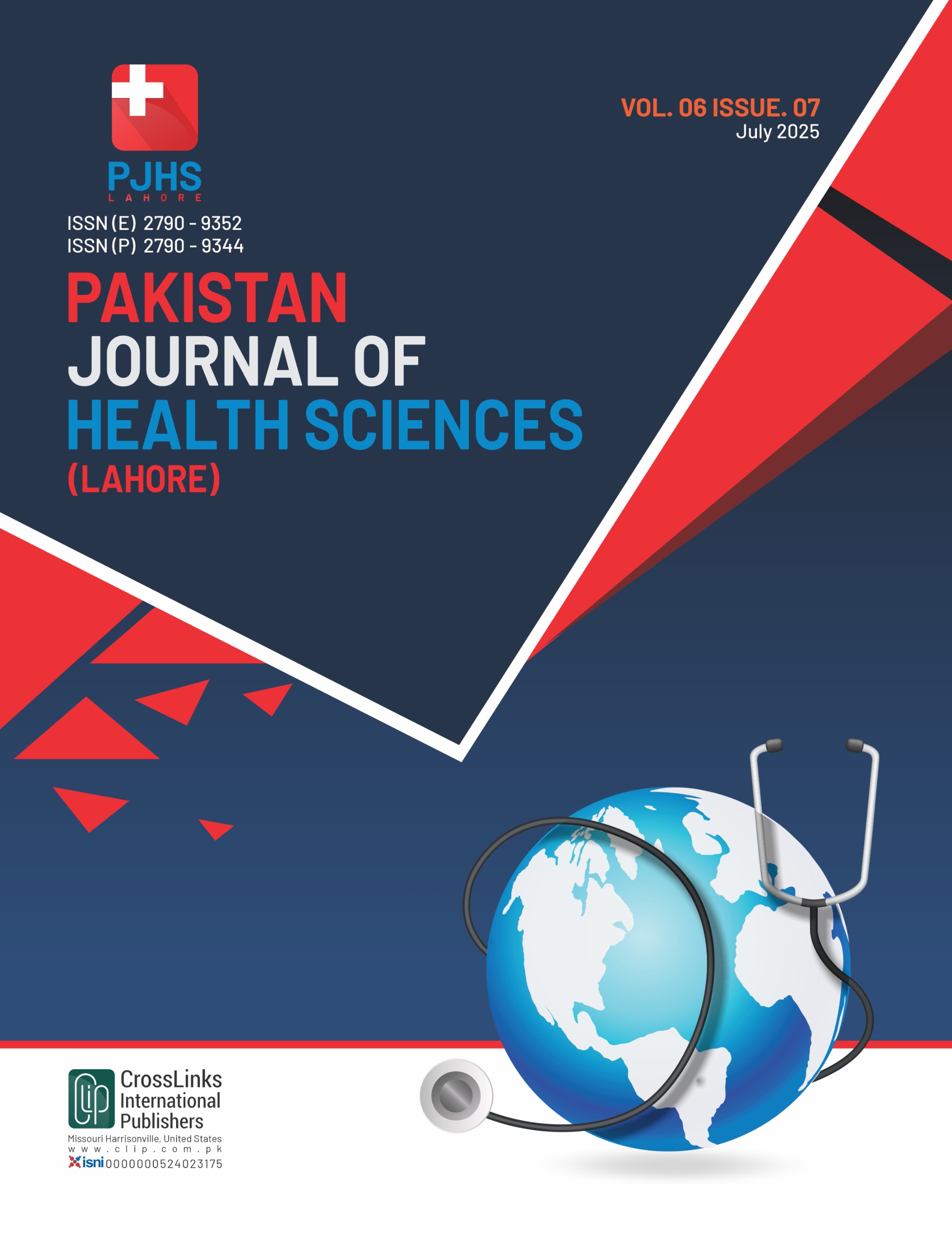Efficacy of Percutaneous Nephrolithotomy in Pediatric Renal Stone Clearance in Khyber Pakhtunkhwa: A Cross-Sectional Analytical Study
Percutaneous Nephrolithotomy in Pediatric Renal Stone Clearance
DOI:
https://doi.org/10.54393/pjhs.v6i7.3344Keywords:
Pediatric Urolithiasis, Renal Stones, Stone Clearance, Percutaneous nephrolithotomy,, Children, Minimally Invasive Surgery, Operative OutcomesAbstract
Renal stone disease is increasingly recognized in the Pediatric population and poses significant clinical challenges. Timely and effective intervention is essential to prevent long-term complications such as recurrent infections, renal damage, or impaired growth. Percutaneous nephrolithotomy (PCNL) has emerged as a key surgical technique in managing moderate to large renal stones in children, but data on its efficacy and safety in the local context remain limited. Objectives: To assess the effectiveness of PCNL in achieving renal stone clearance in Pediatric patients aged 5 to 15 years presenting to a tertiary care centre in Khyber Pakhtunkhwa. Methods: This descriptive study was conducted at the Department of Urology, Institute of Kidney Diseases, Peshawar. A total of 216 children with uncomplicated, single renal stones measuring ≤8 mm, confirmed on a KUB X-ray, were enrolled through consecutive non-probability sampling. Standard PCNL was performed under general Anesthesia, and clearance was assessed postoperatively. Data were analyzed using SPSS version 23.0. Chi-square test was used for associations between stone clearance and variables age, gender, stone size, site, and operative time. Results: Stone clearance was achieved in 78.2% of cases. Clearance was higher in children with smaller stones (≤5 mm) and shorter operative times, though the differences were not significant (p>0.05). No major procedural complications were reported. Conclusions: PCNL is an effective and safe procedure for treating Pediatric renal stones. While factors like stone size and operative duration may influence outcomes, further large-scale studies are warranted to confirm these associations in the Pediatric population of low-resource settings.
References
Khalil MA, Patujo YH, Ullah F, Ibrar U, Adil R, Inam QA et al. An Analysis of Percutaneous Nephrolithotomy (PCNL) Performed at the Institute of Kidney Disease, Pakistan: Stone Clearance and Complications. Cureus. 2024 Dec; 16(12). doi: 10.7759/cureus.75430. DOI: https://doi.org/10.7759/cureus.75430
Shrestha S, Maskey P, Shah JN. Outcome of Mini Percutaneous Nephrolithotomy ‘Mini PCNL’ in Children. Journal of Patan Academy of Health Sciences. 2018 Dec; 5(2): 12-7. doi: 10.3126/jpahs.v5i2.23983. DOI: https://doi.org/10.3126/jpahs.v5i2.23983
Tahir R, Bakar A, Khan UU, Imran M, Ullah H. Safety and Efficacy of Mini-Percutaneous Nephrolithotomy (mini PCNL) in Pediatric Patients with Staghorn Stone: A Single Center Study in Pakistan. 2024. doi: 10.21203/rs.3.rs-4414321/v1. DOI: https://doi.org/10.21203/rs.3.rs-4414321/v1
Ayub MZ, Ahmed I, Saeed K, Ahmed N, Bajwa KM, Saleem A. Comparison of Efficacy of Percutaneous Nephrolithotomy between Supracostal and Subcostal Access in Patients with Renal Stone. Journal of Health and Rehabilitation Research. 2023 Dec; 3(2): 764-9. doi: 10.61919/jhrr.v3i2.246. DOI: https://doi.org/10.61919/jhrr.v3i2.246
Jones P, Hawary A, Beck R, Somani BK. Role of Mini-Percutaneous Nephrolithotomy in the Management of Pediatric Stone Disease: A Systematic Review of Literature. Journal of Endourology. 2021 May; 35(5): 728-35. doi: 10.1089/end.2020.0743. DOI: https://doi.org/10.1089/end.2020.0743
Nerli RB, Ghagane SC, Mungarwadi A, Patil S. Percutaneous Nephrolithotomy in Children. Pediatric Surgery International. 2021 Aug; 37(8): 1109-15. doi: 10.1007/s00383-021-04901-6. DOI: https://doi.org/10.1007/s00383-021-04901-6
Fang H, Wang Z, Wei K, Liu X, Wu S, Hua Y et al. Safety and Efficacy of Standard Vs. Tubeless Percutaneous Nephrolithotomy in Pediatric Populations: An Updated Systematic Review and Meta-Analysis. BioMed Central Urology. 2025 May; 25(1): 110. doi: 10.1186/s12894-025-01798-4. DOI: https://doi.org/10.1186/s12894-025-01798-4
Jaffal WN, Al-Timimi HF, Hassan OA, Mohammad EJ. The Safety and Efficacy of Miniaturized Percutaneous Nephrolithotomy in Children. Urolithiasis. 2024 Oct; 52(1): 142. doi: 10.1007/s00240-024-01643-7. DOI: https://doi.org/10.1007/s00240-024-01643-7
Ahmad T, Minallah N, e Manan F. Safety and Efficacy of Minimally Invasive Percutaneous Nephrolithotomy for Kidney Stones in Infants in Pakistan. In Medical Forum Monthly. 2021; 32(10). doi: 10.3389/fped.2022.1035964.
Rehman OF, Khan A, Harvey H, Umair M, Murtaza B, Nawaz M et al. Mini PCNL: A Viable Single Stage Treatment for Pediatric Nephrolithiasis in Resource Limited Countries. Journal of Pediatric Urology. 2021 Jun; 17(3): 388-e1. doi: 10.1016/j.jpurol.2020.12.015. DOI: https://doi.org/10.1016/j.jpurol.2020.12.015
Ahmad T, Minallah N, Khaliq N, Rashid H, Syed M, Almuradi MA. Safety and efficacy of minimally invasive percutaneous nephrolithotomy for infantile nephrolithiasis. Single centre experience from Pakistan. Frontiers in Paediatrics. 2023 Jan; 10: 1035964. doi: 10.3389/fped.2022.1035964. DOI: https://doi.org/10.3389/fped.2022.1035964
Mahmood SN, Said SH, Mohammed RO, Jaafar MS. Safety and Efficacy of Mini-Percutaneous Nephrolithotomy in Management of Renal Stones in Pediatric Age Group. BioMed Central Nephrology. 2025 Mar; 26(1): 111. doi: 10.1186/s12882-025-04031-4. DOI: https://doi.org/10.1186/s12882-025-04031-4
Peng T, Zhong H, Hu B, Zhao S. Minimally Invasive Surgery for Pediatric Renal and Ureteric Stones: A Therapeutic Update. Frontiers in Paediatrics. 2022 Aug; 10: 902573. doi: 10.3389/fped.2022.902573. DOI: https://doi.org/10.3389/fped.2022.902573
Kumar N, Yadav P, Kaushik VN, Kakoti S, Chakraborty A, Kumar D et al. Mini-Versus Standard Percutaneous Nephrolithotomy in Pediatric Population: A Randomized Controlled Trial. Journal of Pediatric Urology. 2023 Dec; 19(6): 688-95. doi: 10.1016/j.jpurol.2023.08.013. DOI: https://doi.org/10.1016/j.jpurol.2023.08.013
Akdogan N, Deger M, Zubaroglu M, Yilmaz IO, Arikan MG, Satar N et al. Predictive Value of Scoring Systems for Stone Free Status and Complications Before Percutaneous Nephrolithotomy in Children. Scientific Reports. 2025 Mar; 15(1): 8292. doi: 10.1038/s41598-025-91760-z. DOI: https://doi.org/10.1038/s41598-025-91760-z
Fernandez N, Ellison JS, Wang Z, Huang J, Chu DI, Sturm R et al. Surgeon, and Institution Characteristics Associated Surgical Preferences in the Pediatric Kidney Stone Care Improvement Network. Urology. 2024 May; 187: 64-70. doi: 10.1016/j.urology.2024.02.040. DOI: https://doi.org/10.1016/j.urology.2024.02.040
Juliebø-Jones P, Ulvik Ø, Beisland C, Somani BK. Paediatric Percutaneous Nephrolithotomy (P-PCNL) Reporting Checklist. Scandinavian Journal of Urology. 2023 Jan; 58(1). doi: 10.2340/sju.v58.13392. DOI: https://doi.org/10.2340/sju.v58.13392
Ahmad T, Ullah E, Ur Rehman I, Sabir M, Muhammad S, Ali M. Comparison of the Efficacy and Safety of Extracorporeal Shock Wave Lithotripsy and Mini Percutaneous Nephrolithotomy in Treating Renal Pelvis Calculus in Infants. Journal of Pediatric Endoscopic Surgery. 2025 Mar: 1-5. doi: 10.1007/s42804-025-00265-z. DOI: https://doi.org/10.1007/s42804-025-00265-z
Ellison JS, Chu DI, Nelson CP, DeFoor WR, Ziemba J, Huang J et al. Percutaneous Nephrolithotomy vs Ureteroscopy for Kidney Stones in Children. Journal of the American Medical Association Network Open. 2025 Jun; 8(6): e2516749-. doi: 10.1001/jamanetworkopen.2025.16749. DOI: https://doi.org/10.1001/jamanetworkopen.2025.16749
Sharma G, Sharma A, Devana SK, Singh SK. Mini Versus Standard Percutaneous Nephrolithotomy for the Management of Renal Stone Disease: Systematic Review and Meta-Analysis of Randomized Controlled Trials. European Urology Focus. 2022 Sep; 8(5): 1376-85. doi: 10.1016/j.euf.2021.07.014. DOI: https://doi.org/10.1016/j.euf.2021.07.014
Downloads
Published
How to Cite
Issue
Section
License
Copyright (c) 2025 Pakistan Journal of Health Sciences

This work is licensed under a Creative Commons Attribution 4.0 International License.
This is an open-access journal and all the published articles / items are distributed under the terms of the Creative Commons Attribution License, which permits unrestricted use, distribution, and reproduction in any medium, provided the original author and source are credited. For comments













